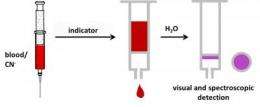Rapid response in cases of smoke poisoning

Smoke poisoning can be caused by a number of things, including cyanides, the salts of hydrocyanic acid. Because the quick diagnosis and treatment of victims with cyanide poisoning is critical and often lifesaving, it is very surprising that a cyanide test for emergency situations is not yet available. Now, chemists at the University of Zurich have developed a simple and reliable procedure to detect blood cyanide in less than two minutes.
The main cause of cyanide poisoning is smoke inhalation in closed spaces during fires. Cyanides, the salts of hydrocyanic acid, inhibit cellular respiration and may lead to coma or death. The rapid administration of a cyanide antidote is essential for successful treatment. Previously, detecting cyanide in the blood took up to an hour and could only be performed in the laboratory, a lengthy process that is poorly suited for emergency situations. As a result, emergency doctors and paramedics are forced to administer antidotes based solely on presumptive diagnoses. Now, chemists at the University of Zurich have succeeded in detecting blood cyanide in less than two minutes and without any laboratory equipment: UZH chemists Christine Männel-Croisé and Felix Zelder combined a cyanide color test with an extraction method to produce results quickly and reliably.
The newly developed procedure works with only a tiny drop of blood mixed in a detection vial with a pH buffer, water, and a cobalt-based chemosensor. If the blood contains cyanide, the solid phase of the vial turns purple.
Faster, easier, more versatile
"What I like most about our method is that detection is possible solely with the naked eye, and it needs only a drop of blood," says Zelder. Quantitative measurements are also possible, thereby enabling emergency responders to determine the grade of cyanide poisoning. The correct dosage of antidote can be chosen, and detoxification can be monitored during treatment. "In principle, our method meets all the requirements for application in emergency situations," explains Christine Männel-Croisé. Currently, Männel-Croisé and Zelder are in discussion with paramedics to test their method in cases of emergency.
More information: Christine Männel-Croisé and Felix Zelder. Anal. Methods, 2012, 4, 2632.

















